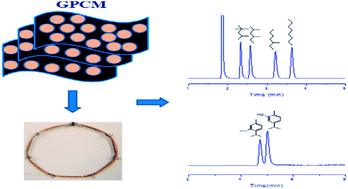A graphene-based porous carbon material as a stationary phase for gas chromatographic separations
Abstract
This work presents the separation performance of a 3D graphene-based porous carbon material (GPCM) as a new stationary phase for capillary gas chromatography (GC). The statically coated GPCM column showed a column efficiency of 3210 plates per m and weak polar nature. Its resolving capability and retention behaviours were investigated by using structural and positional isomers and a complex mixture covering analytes of diverse types. The GPCM column exhibits high resolution for nonpolar to polar isomers and analytes of wide ranging variety. It also displays a different retention mechanism from the commercial polysiloxane column, showing preferential retention of alcohols, aromatics and halogenated compounds. In addition, the GPCM column exhibited good column repeatability and reproducibility with RSD values on retention times in the range of 0.01–0.03% for intra-day, 0.06–0.36% for inter-day and 0.44–2.1% for between-column, respectively. The advantageous separation performance shows the good potential of the GPCM stationary phase for GC analysis.



 Please wait while we load your content...
Please wait while we load your content...